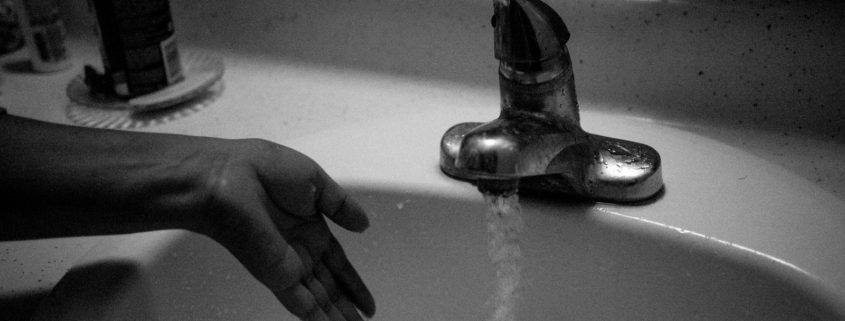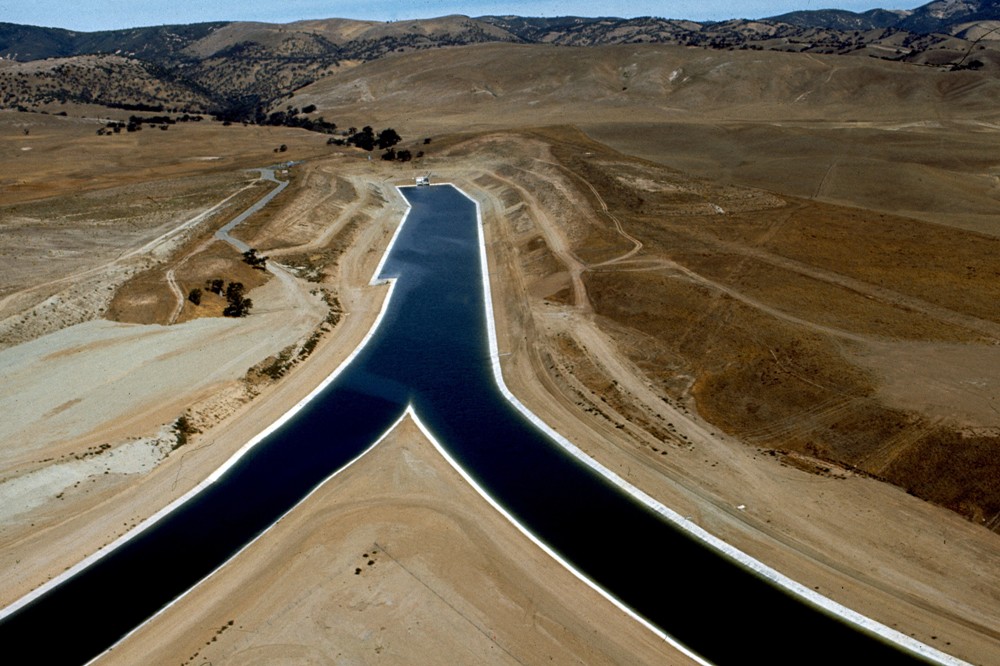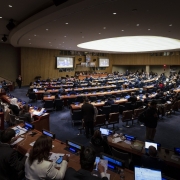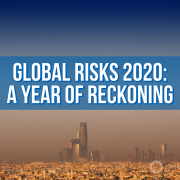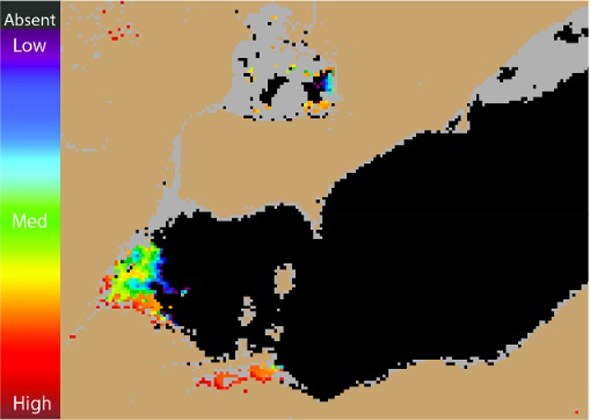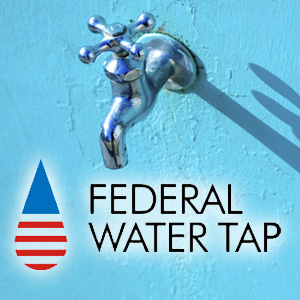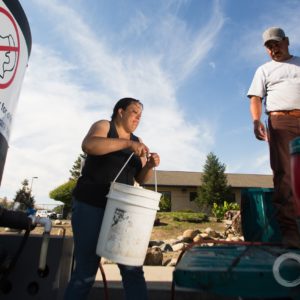California’s Clean-Water-for-All Experiment Begins to Deliver
The state was the first in the U.S. to declare a human right to water.
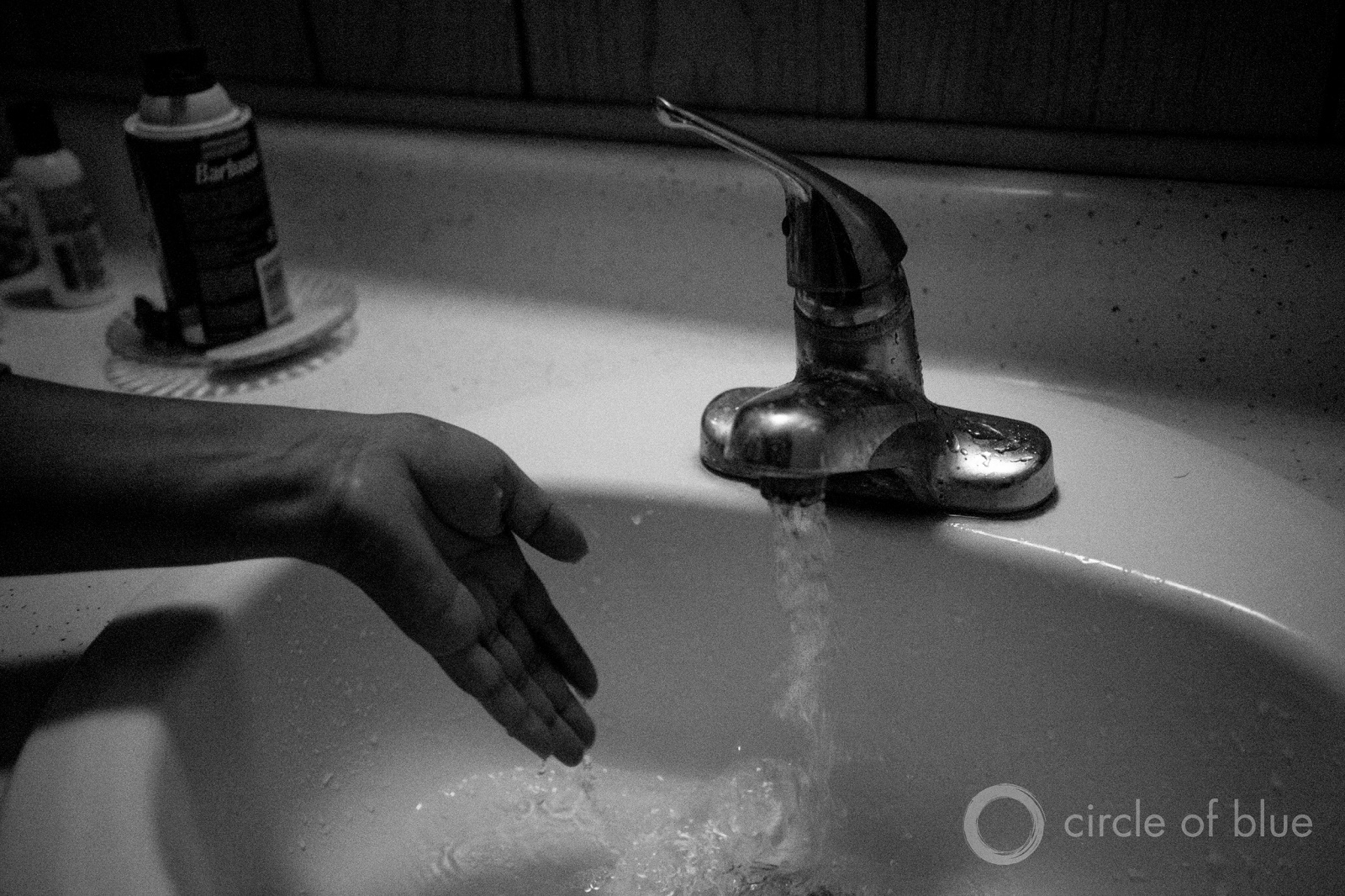
Gabriela Rodriguez prepares to give her baby a bath at their home in Kettleman City, in California’s San Joaquin Valley. Many residents of this small farmworker community fear their water supply after a rash of defects struck the town. Photo © Matt Black for Circle of Blue
By Brett Walton, Circle of Blue
Hundreds of thousands of California residents, perhaps as many as one million of the 39 million people in the state, do not have safe drinking water or toilet facilities. The wide gap in access to a basic need became a rallying cry more than a decade ago when social justice advocates began promoting a new water strategy for California, a strategy that resulted, in 2012, in a first-of-its-kind state statute that declared safe, clean, affordable water and sanitation a human right.
Lawmakers encounter those principles today as they debate how to fund water system maintenance for poor communities and design the nation’s first state-run water utility bill assistance program.
The right-to-water movement took time to accumulate allies. It persevered through skepticism and a governor’s veto. But then on September 25, 2012, Gov. Jerry Brown signed AB 685, which stated that “every human being has the right to safe, clean, affordable, and accessible water adequate for human consumption, cooking, and sanitary purposes.” The law also asked, but did not require, state agencies to consider that policy in their work. California, a leader in so many environmental laws, was the first state to enact such legislation.
Five years later, what has the law amounted to? Quite a lot, especially during the state’s recent deep drought, which gave the law’s goals a boost. Far from being the symbolic gesture that some assumed it would be, the law has resulted in significant adjustments to state policy and practice.
“There’s been a sea change in how the state thinks about water — which is saying something in a state in which water is highly politicized and low-income communities are on the short end of the stick for access,” said Britton Schwartz, a fellow at the Environmental Law Clinic at the University of California, Berkeley and a long-time advocate for the human right to water.
Circle of Blue interviewed 18 people who have played a role in passing the human right to water legislation and implementing it: lawmakers who introduced bills to extend water access, organizers who built coalitions in support of the law, utility trade groups, people from communities with dirty water, and state officials who are turning the words of the law into actions.
In these conversations, a consensus evaluation emerged. First, the law has, without a doubt, resulted in substantial changes to state water policy. Responsibility for drinking water is now consolidated in a single agency, the State Water Resources Control Board, which, thanks to new legal authority, has added programs and tools for assessing water needs and responding to them. Voter-approved bonds and state budgets have freed up hundreds of millions of dollars for water projects in poor communities. The management process is more inclusive, too. More people have a voice in water decisions, and state regulators and water managers are paying closer attention to the needs of communities on the margin.
“What the law does is more important than mandating water deliveries. It democratizes the decision-making process,” said Mike Eng, a former Assembly member and the sponsor of AB 685. “That’s the enduring worth of the human right to water.”
Second, there is still much work to do. If policy changes and more democratic management have set the playing field, the game itself is just beginning. Sustainable drinking water solutions have been achieved for only a few of the hundreds of thousands in need, and sanitation has largely been ignored. Some of the legal powers the state acquired, including a law requiring stricter oversight of groundwater, a flashpoint for water access in the recent drought, are still too young to have had an effect. There will be tough financial choices ahead for a state that is also prioritizing investments in flood control, dam repairs, water recycling, and water storage.
“The statute is only just now starting to unspool in a way that might affect change,” asserted Mike Antos, senior watershed manager at the Santa Ana Watershed Project Authority.
The third consensus view is that the main obstacles to the clean-water-for-all goal are money and preventing rivers and aquifers from being polluted in the first place. Who pays? and How much? are questions of the day in the Legislature, which is debating a bill to fund the operation and maintenance of water systems in poor communities. Funding will also be a point of contention for the state-run water affordability program, which the State Water Board will present to the Legislature by February.
It was a radical idea once, the human right to water. Over the years, the idea has gained slow acceptance in California. In the beginning, though, it did not always seem that such progress would be made.
A History of Neglect
The Salinas Valley, extending inland like a splinter from the central California coast, is an agricultural dynamo, often called America’s salad bowl. It produces more than half of the nation’s broccoli and lettuce along with dozens of other crops. It’s also a region rich in the history of two related social movements — the struggle for farmworker justice and the human right to safe water.
Horacio Amezquita, since he was a teenager, has lived through both. The valley’s farmworker community, mostly immigrants to the land of plenty, had little power and less money when they sought permanent housing after being evicted from a Salinas Valley worker’s camp in the early 1970s following a labor strike.
Kicked out of La Posada trailer park in Salinas, some of the workers fixed their sights on an abandoned camp south of the city set amid the fields in which they toiled. It was a long campaign. Years of negotiating land rights, acquiring the land, fending off opposition from schools and growers, and securing federal development loans culminated in 1979 with the construction of San Jerardo Cooperative, where Amezquita lived for 34 years and is now the general manager.
With 60 homes and four rental units, San Jerardo was the first housing cooperative in California organized by farmworkers, and it laid a legal foundation for five other cooperatives in Monterey County.
Then came the fight for clean water. Not that many years after the homes were built the community’s wells started to turn sour for the roughly 250 residents of San Jerardo. Chemicals and nutrients applied to fields of strawberries and grapes, broccoli and lettuce, cauliflower and cabbage to kill insects and make the berries grow fat had moved downward into groundwater.
In 1990, San Jerardo’s first well tested above state standards for nitrate, a byproduct of plant vitamins that is suffocating for infants. The water also contained 1,2,3-TCP, a fumigant and pesticide. Three years later a second well was spoiled. The third and final well was condemned in 2001, and the residents of San Jerardo started to use bottled water for drinking and cooking.
Poor and cut off from traditional networks of political power, San Jerardo and communities like it dot the map of California. With the human right to water, they sought a voice that had been denied for so long.
If At First You Don’t Succeed…
In the last days of February 2009, an unusual bill appeared in the California Assembly. AB 1242 ordered state agencies “to employ all reasonable means” to secure “clean, affordable, and accessible water” for all human beings. Though Massachusetts and Pennsylvania had clean water clauses in their constitutions, no state had passed a right-to-water law with a scope as wide as what AB 1242 proposed.
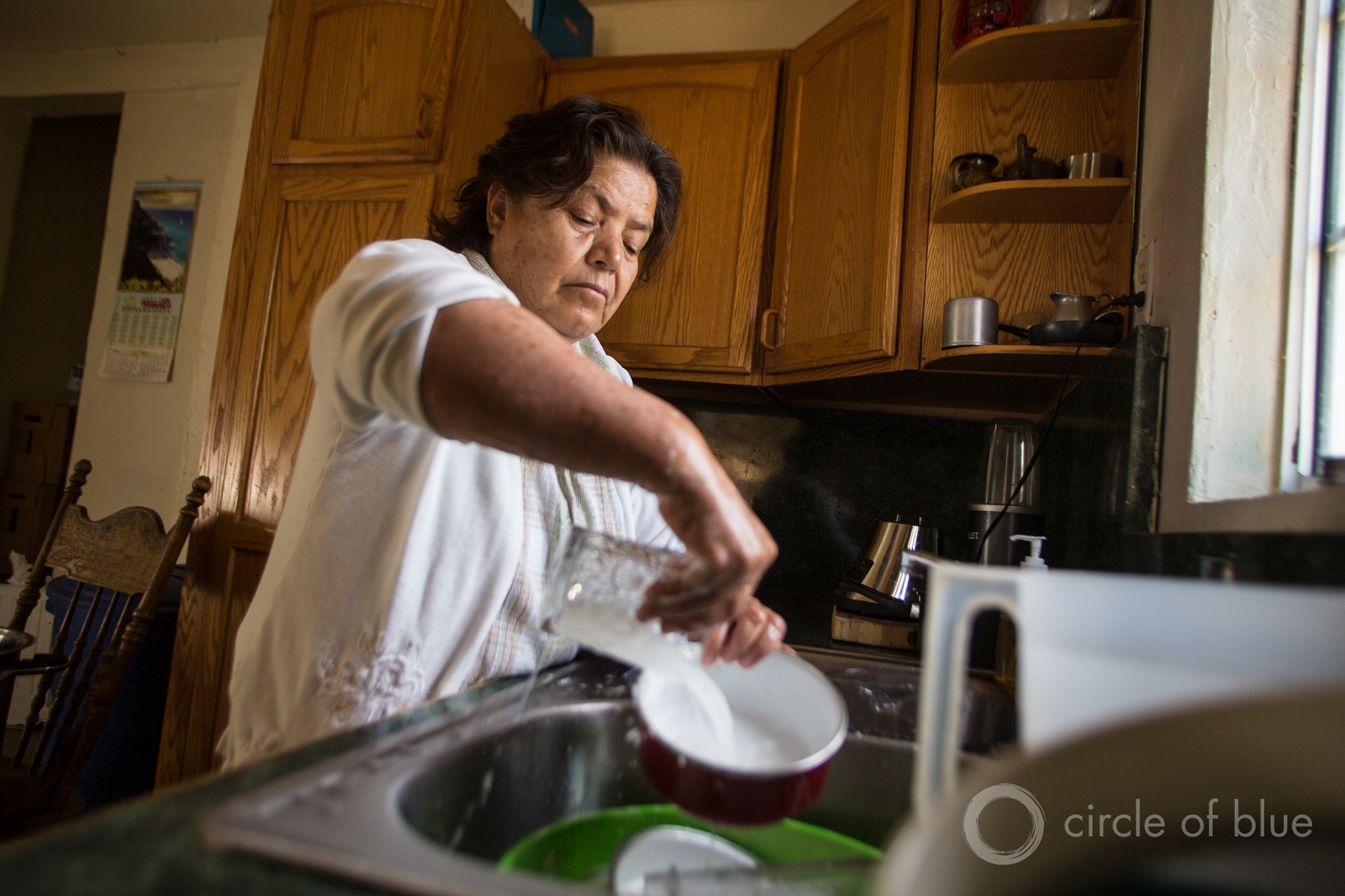
Belan Ruia makes every drop of water count as she washes dishes in April 2015 in her East Porterville, California, home. Like her neighbors, her well went dry during the state’s historic drought. She and her husband, Artemio, got water from a nearby fire station. Photo © J. Carl Ganter / Circle of Blue
Supporters knew that they faced a difficult path, and they were proved correct. Though it cleared the Legislature, the bill did not earn the governor’s endorsement.
On October 12, 2009, Gov. Arnold Schwarzenegger vetoed AB 1242. Schwarzenegger “wholeheartedly” supported the bill’s premise, but signing it into law, he argued, would result in lawsuits rather than water access.
“We should be doing everything we can to ensure that our communities have access to clean, affordable water for our citizens,” Schwarzenegger wrote in his veto message. “But the language of this bill will undoubtedly lead to potentially costly and constant litigation. This moves our limited state resources away from the day to day operations of achieving our clean water goals and puts them in the courtroom.”
Schwarzenegger instead signed two bills that directed state and federal money to poor communities. “Our most pressing barrier in achieving this goal is not desire, it is funding,” he wrote, presaging an argument that continues to this day.
Try, Try Again
Supporters of the bill were not deterred by the failure. In other arenas, in fact, they were making progress. After years of debate, the United Nations General Assembly, on July 28, 2010, passed a resolution that recognized the human right to water. It was a landmark accomplishment for human rights campaigners.
Advocates in California used the UN action to their advantage. They invited the UN’s appointed expert on water and sanitation to witness the state’s shortcomings.
In February and March of 2011, Catarina de Albuquerque, the UN expert, came to the United States to investigate water and sanitation access for the poor and marginalized. In California, she toured Seville, a town in the San Joaquin Valley with groundwater polluted by nitrate. She met with leaders of the Winnemen Wintu tribe, who worried about the destruction of traditional fishing sites and cultural grounds. She visited a homeless camp in Sacramento in which a self-appointed “sanitation technician” hauled the camp’s human waste — between 130 pounds and 230 pounds per week — on his bicycle to a public restroom where he flushed the mess down the toilet.
“It was a real eye-opener for a lot of people at all levels that there is a problem equivalent to what’s going on in third-world countries,” recalled Maria Herrera, then working at the Community Water Center and now at Self-Help Enterprises, a community development organization in the San Joaquin Valley.
That same winter, in February, the human right to water bill was revived in the California Assembly by Mike Eng, a former member of the Monterey Park City Council.
Like the residents of San Jerardo, Eng lived in a community with a contaminated groundwater supply. Perchlorate, an ingredient in rocket fuel, tainted two of Monterey Park’s 11 wells. Arsenic was found in concentrations above state standards in six wells.
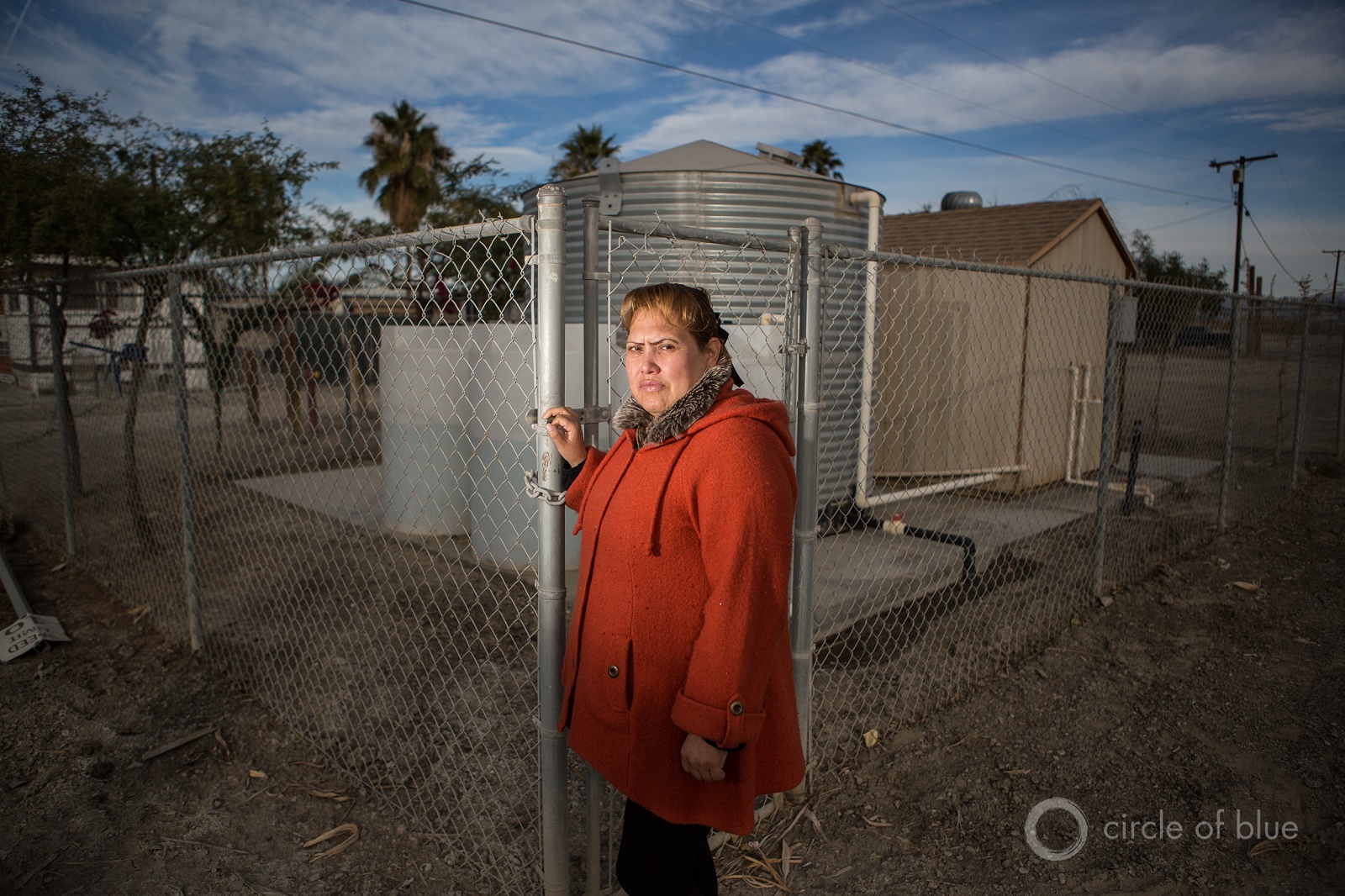
Migrant communities in southern California have to rely on unsafe groundwater supplies or drive to access clean supplies. A water filtration station in the Coachella Valley removes arsenic from groundwater. Photo © J. Carl Ganter / Circle of Blue
A deep but relatively narrow coalition led the campaign. There were social justice groups with an environmental focus such as the Environmental Justice Coalition for Water, Community Water Center, Food and Water Watch, and Clean Water Action. Environmental groups like the Natural Resources Defense Council and Sierra Club took part, too. The Winnemem Wintu tribe was a sponsor. There were also religious groups such as the Unitarian Universalist Services Committee, which was active in the campaign to get the UN to recognize a right to water, and the Catholic Charities Diocese of Stockton.
Britton Schwartz, who worked for the Community Water Center at that point, was one of the organizers on the frontlines and helped to educate elected officials and bureaucrats about the goals of the bill. In 2008 and 2009, she attended county Board of Supervisors meetings, regional water planning meetings, Department of Public Health meetings — any meeting in which water was being discussed. The message, unfamiliar to many in those rooms, that clean drinking water was a legal right turned heads.
“People were looking at me like an alien,” Schwartz recalled.
Campaigners took their message directly to lawmakers, organizing rallies on the Capitol steps. In a parody of the wine industry, they handed out bottles of Central Valley Special Blend, water that was contaminated with arsenic, uranium, bacteria, nitrate, 1,2,3 TCP, and other chemicals. “DO NOT DRINK,” the label read. “100% Community Tap Water.”
De Albuquerque, the UN expert, returned to the state to speak in favor of the bill, which was opposed by large water utilities and farm groups.
Amezquita remembers driving three or four hours to Sacramento to lobby lawmakers. “A lot of organizing took place to fight for the human right to water,” he said.
The law’s passage was also a result of the maturation of the environmental movement in California, a “coming of age,” in the words of Colin Bailey, now the executive director of the Environmental Justice Coalition for Water. By 2012, people who started as organizers had moved into positions of power, he said.
Martha Guzman Aceves, for instance. Formerly a legislative coordinator for United Farm Workers and a co-founder of the Environmental Justice Coalition for Water, Guzman Aceves was named Gov. Brown’s deputy legislative affairs secretary in 2011. She was responsible for environmental and natural resources bills and the human right to water law was in her portfolio.
The bill supporters made a strategic move, Guzman Aceves said, when they changed the language of AB 685 to remove any hint of legal obligation on the part of the state or utilities. That modification sidestepped the core question and rallying point for opposition to the human right to water, which is how do you deliver?
“For someone to say you have a right to water means that someone else is required to give it,” said Doug LaMalfa, then a state senator and now a member of the U.S. House of Representatives, during the floor debate in the Senate. LaMalfa voted no.
Unlike the attempt three years earlier, Eng and supporters took a different tack. Instead of mandating any specific action on the part of utilities or state agencies, the bill advanced a “moral policy statement,” explained Guzman Aceves, who now holds a seat on the California Public Utilities Commission.
“Once we have a common baseline, we can build off it,” she said. “And that’s what happened.”
The amended language was enough to push the bill across the finish line. Gov. Brown signed the bill into law on September 25, 2012.
It was a euphoric moment for the campaigners. But they were also aware of the challenges still to come.
“Today we’re celebrating this great victory, but tomorrow means implementation,” said Susana De Anda, co-founder of the Community Water Center, in October 2012. “Tomorrow means really ensuring that safe drinking water comes out of people’s taps. We recognize that justice might take a long time but we’re committed to the end.”
Brett writes about agriculture, energy, infrastructure, and the politics and economics of water in the United States. He also writes the Federal Water Tap, Circle of Blue’s weekly digest of U.S. government water news. He is the winner of two Society of Environmental Journalists reporting awards, one of the top honors in American environmental journalism: first place for explanatory reporting for a series on septic system pollution in the United States(2016) and third place for beat reporting in a small market (2014). He received the Sierra Club’s Distinguished Service Award in 2018. Brett lives in Seattle, where he hikes the mountains and bakes pies. Contact Brett Walton

